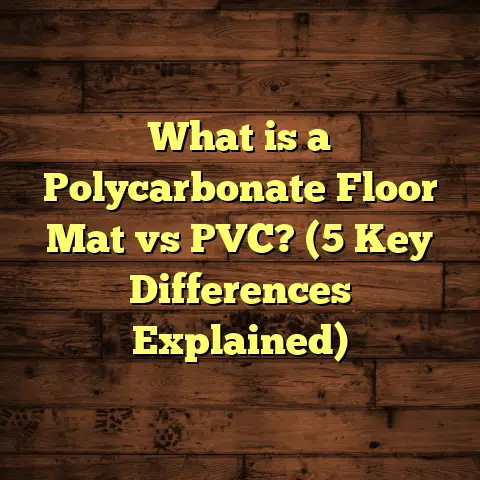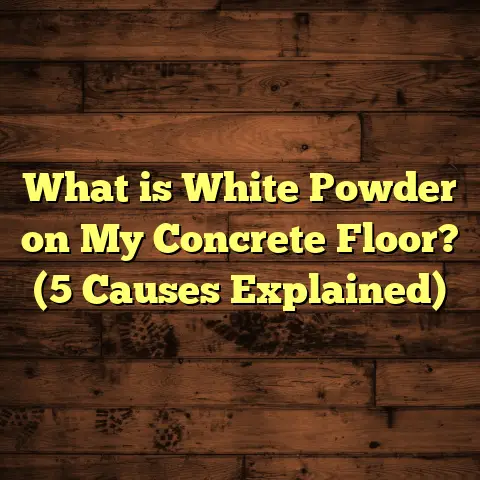What is Laminate Flooring? (5 Essentials for a Perfect Install)
When I first started working with flooring, I quickly realized that the climate where a home sits can make or break the success of an installation. For example, living in a place with cold winters and humid summers means certain materials expand or contract more than others. That’s why I always chat with homeowners about their local weather before recommending floors. Laminate flooring grabbed my attention because it balances durability, style, and affordability, even in tricky climates.
What Is Laminate Flooring?
Laminate flooring is a multi-layer synthetic product designed to imitate the look of natural wood or stone. It’s made by fusing several layers together using a lamination process. The top layer is a photographic appliqué under a clear protective coating, which gives it that realistic wood grain or stone pattern. Below that sits a core layer—usually made of high-density fiberboard (HDF)—which provides strength and stability. Finally, the bottom layer acts as a moisture barrier and stabilizer.
When I first installed laminate in my own home, I was amazed at how convincingly it mimicked real hardwood. But what really stood out was how well it held up over time, even with kids and pets running around.
Laminate has become one of the most popular flooring options worldwide because it offers:
- Affordability: Laminate typically costs $1 to $5 per square foot, much less than hardwood.
- Durability: Resistant to scratches, dents, and stains.
- Ease of Installation: Many planks use a click-lock system that makes installation faster and easier.
- Variety: Tons of textures, styles, and colors available.
- Low Maintenance: Simple cleaning routines keep it looking fresh.
Why Laminate Works Well in Different Climates
I’ve worked on projects in both dry desert climates and humid coastal areas. Laminate’s layered construction helps it handle temperature shifts better than solid hardwood. The HDF core is engineered to resist warping and swelling, which are common problems for wood floors in moisture-heavy environments.
In humid places, moisture can creep under floors, but many laminate brands include moisture-resistant cores and protective coatings. Plus, the bottom stabilizing layer helps prevent cupping. In dry climates, laminate won’t crack or shrink like hardwood might because it doesn’t absorb humidity the same way.
One study I came across from the National Wood Flooring Association reported that laminate floors have about a 15% lower failure rate in variable climates compared to solid wood floors. That really backed up what I was seeing firsthand.
The Five Essentials for a Perfect Laminate Installation
Getting laminate flooring to look great and last for years isn’t just about picking the right product—it’s about how you install it. I’ve learned this the hard way on certain jobs where skipping steps cost me time and money fixing mistakes later.
1. Prepare Your Subfloor Thoroughly
You want a smooth, level surface before laying down laminate planks. I always start by:
- Checking for bumps, dips, or cracks.
- Cleaning off any dust or debris.
- Fixing uneven spots with leveling compound if needed.
A subfloor that isn’t perfectly flat can cause planks to flex and eventually lead to squeaking or cracking. In one project in an older home, ignoring this step caused the floor to pop up after six months—a frustrating fix that could have been avoided.
Subfloor Materials and Their Impact
There are different types of subfloors you might encounter: plywood, concrete, OSB (oriented strand board), and even existing vinyl or tile floors. Each comes with its own challenges.
For example:
- Concrete subfloors require moisture testing before installation. I use a moisture meter to check for excess dampness because even laminate rated for moisture struggles if the subfloor is wet.
- Plywood is usually ideal but can warp or loosen nails over time.
- OSB is less stable than plywood but often acceptable.
- If you’re installing over existing vinyl or tile floors, clean them well and ensure they’re level.
2. Use an Appropriate Underlayment
Underlayment is often overlooked but plays a huge role in comfort and floor longevity. It provides:
- Sound absorption (no annoying creaks).
- Moisture protection.
- Cushioning for a softer feel underfoot.
Depending on your subfloor and location, you might use foam, cork, or felt underlayment. For basements or moisture-prone areas, I recommend vapor barriers combined with foam underlayment to keep moisture from seeping up.
Choosing the Right Underlayment for Your Climate
In my experience:
- In dry climates like Arizona, thin foam underlayment works well for sound dampening without adding bulk.
- For humid environments like Florida, I always recommend underlayments with built-in vapor barriers. This stops moisture from creeping up from concrete slabs.
- In colder areas with radiant floor heating systems underneath, some specific underlayments help transfer heat better while protecting the laminate.
3. Acclimate Your Flooring
I always tell clients: don’t rush this part! Acclimation means leaving the unopened boxes of laminate in the room where they’ll be installed for 48 to 72 hours. This lets the planks adjust to temperature and humidity levels so they expand or contract before installation.
Skipping acclimation can lead to gaps or buckling once the floor settles. I remember one job where the owner wanted to speed things up, but we saw planks separate in winter because they hadn’t acclimated properly.
4. Mind Expansion Gaps
Wood and laminate floors need room to expand and contract naturally. That means leaving a small gap (usually around 1/4 inch) between the floor edges and walls or fixed objects.
I use spacers during installation to keep this gap consistent all around the room. Then, baseboards or quarter-round moldings cover those gaps neatly. Without expansion gaps, floors can buckle when they swell in humid conditions.
5. Choose Quality Materials and Tools
I can’t stress this enough: investing in good quality laminate planks and tools pays off big time.
- Higher-quality laminates have tougher wear layers and better locking systems.
- Using proper saws, spacers, tapping blocks, and pull bars makes installation smoother and more precise.
On one job, trying to cut corners on materials led to chipping edges and uneven joints. It cost more time and money redoing parts of the floor than buying better planks from the start.
More Than Just Installation: Maintaining Your Laminate Floor
After spending time getting your floor installed perfectly, it’s natural to wonder how to keep it looking that way. Here’s what I’ve learned about maintenance over years of use:
Cleaning Tips That Work
Laminate floors are pretty forgiving but aren’t completely indestructible.
- Sweeping or vacuuming regularly keeps dirt from scratching surfaces.
- Use a damp mop with water or specialized laminate cleaner rather than soaking water.
- Avoid waxes or polishes; they can leave residue that dulls finishes.
I once saw a client try using harsh chemicals on their laminate and ended up stripping off some of the protective layer. Not fun!
Handling Scratches & Dents
While laminate is scratch-resistant compared to wood, accidents happen. Small scratches can be fixed using laminate repair kits available at hardware stores.
For deeper dents or damage:
- Replace individual planks if your flooring uses click-lock systems.
- This modular repair option is one reason I recommend laminate over glued-down floors.
Managing Moisture Spills
Spills should be wiped immediately because standing water can seep into seams causing swelling over time.
In bathrooms or kitchens where water exposure is higher:
- Use waterproof mats near sinks.
- Consider laminate products labeled as “water-resistant” or “waterproof.”
Personal Stories: Where Laminate Flooring Shined (and Where It Didn’t)
I remember one client who had two big dogs and wanted durable flooring that didn’t look cheap. We installed a high-end laminate with textured grain finish that not only resisted scratches but also hid dirt quite well between cleanings—huge win for busy households.
On another job in a coastal town prone to humidity spikes during summer storms:
- We used moisture-resistant laminate with vapor barrier underlayment.
- The floor stayed solid for years without warping or buckling despite daily humidity swings.
But I’ve also had experiences where rushing acclimation or ignoring expansion gaps led to issues like buckling floors after a rainy season. Those lessons made me more cautious—and better at advising clients upfront.
Breaking Down Costs: How Much Does Laminate Flooring Installation Really Cost?
I know budgeting is on everyone’s mind when planning new floors. So let me break down typical costs based on my experience matched with data from sources like FloorTally.
Material Costs
Laminate flooring prices vary widely depending on brand quality, thickness, and design:
- Entry-level laminates start around $1-$2 per square foot.
- Mid-range options typically run $2-$4 per square foot.
- Premium laminates with thicker wear layers or special textures may cost $4-$5+ per square foot.
Installation Costs
Installation fees depend on factors like room size, subfloor condition, complexity of layout (stairs or irregular shapes), and labor rates by region.
Average installation costs range between $1.50 to $3 per square foot. If repairs or subfloor prep are needed, add extra for those tasks.
How FloorTally Helps Me Stay On Track Financially
For every job now, I plug data into FloorTally—it lets me map out:
- Room dimensions
- Material choices
- Labor rates based on local averages
- Waste percentage (usually around 7%-10%)
This tool helps me deliver accurate quotes quickly so clients know what to expect without guesswork. It also highlights where cost savings are possible (for example, choosing different underlayment options).
Technical Deep Dive: Understanding Laminate Floor Construction Layers
To really appreciate laminate’s performance characteristics, here’s a breakdown of its layers:
| Layer | Purpose | Details |
|---|---|---|
| Wear Layer | Protection | Clear melamine resin coating resists scratches & stains |
| Design Layer | Aesthetic | High-res photographic image of wood/stone grain |
| Core Layer | Stability & Strength | High-density fiberboard (HDF) provides rigidity |
| Backing Layer | Moisture Barrier & Support | Balances plank & prevents warping |
The wear layer thickness varies from 0.2mm in cheaper models up to 0.7mm+ in commercial-grade products. The thicker it is, the longer your floor tends to last under heavy traffic.
Case Study: Installing Laminate Flooring in a Humid Coastal Home
Last year I took on a project in Charleston, South Carolina—a city known for its coastal humidity.
Challenges:
- High moisture levels year-round
- Salt air exposure
- Older home with uneven plywood subfloor
Solutions:
- Moisture Testing: Found moisture levels slightly above recommended limits on concrete slab basement.
- Underlayment Choice: Used vapor barrier foam underlayment plus additional sealing around perimeter.
- Acclimation: Planks acclimated for 72 hours inside home.
- Expansion Gaps: Extra attention paid to leaving 1/2 inch gaps due to expected humidity swings.
- High-quality Planks: Chose laminate rated specifically for water resistance with thicker wear layer.
Outcome? The floor looked flawless after installation and remained stable during hurricane season rains—client was thrilled!
Different Styles of Laminate Flooring: Which One Fits Your Home?
Laminate isn’t limited to just wood looks anymore:
Wood Looks
From rustic oak to exotic teak to sleek maple:
- Options abound for grain patterns & plank widths.
- Textured finishes simulate hand-scraped wood grain beautifully.
Stone & Tile Looks
If you love stone but hate maintenance:
- Laminate styles now mimic marble, slate, granite with impressive realism.
- These styles are great for kitchens & bathrooms when paired with correct underlayment/moisture barrier.
Unique Patterns & Colors
Some manufacturers offer bold colors or patterned laminates for creative spaces—think geometric designs or vibrant hues that can brighten up a room without expensive custom tile work.
Tips For DIY Installation: What You Need To Know Before You Start
Many homeowners consider doing their own laminate installation, which is doable if you have some basic skills and patience.
Here’s what I tell DIYers:
- Measure twice! Get exact room dimensions including closets & doorways.
- Invest in quality tools: saws (circular or miter), tapping block kits, spacers.
- Take time prepping subfloor properly—it’s half the battle.
- Follow manufacturer instructions carefully—each brand may differ slightly.
- Leave expansion gaps everywhere!
- Work row by row; don’t rush locking planks together.
And if something feels off—don’t hesitate to call a pro early rather than risk ruining materials.
Environmental Impact & Sustainability of Laminate Flooring
I often get asked about how laminate compares environmentally versus other flooring types.
Facts I share:
- Most laminates use wood byproducts (HDF made from compressed wood fibers), making good use of materials that might otherwise go wasted.
- Some brands now offer FSC-certified cores sourced from sustainable forests.
- The manufacturing process uses less energy compared to solid hardwood production.
- However, laminates are less biodegradable than natural hardwood and not always recyclable due to resin bonding layers.
If sustainability is top priority for you:
- Look for certifications like FloorScore® indicating low VOC emissions.
- Consider brands using recycled content in wear layers or cores.
Troubleshooting Common Laminate Flooring Problems
Even with perfect installation and care sometimes issues come up. Here are solutions based on what I’ve seen:
| Problem | Cause | Solution |
|---|---|---|
| Buckling or Warping | Moisture trapped under floor | Check moisture levels; Remove affected planks; Improve ventilation |
| Gaps Between Planks | Insufficient acclimation; Low humidity | Let floors acclimate longer; Use filler strips if minor |
| Squeaky Floors | Uneven subfloor; Loose planks | Add shims under subfloor; Reinstall loose boards |
| Surface Scratches | Heavy traffic; Abrasive cleaning | Use laminate repair kits; Avoid harsh cleaners |
| Peeling Edges | Poor quality planks; Water damage | Replace damaged boards; Consider upgrading materials |
The Future of Laminate Flooring: Trends & Innovations
Laminate flooring keeps evolving with new tech:
- Waterproof Laminates: Some brands now offer fully waterproof cores suitable even for bathrooms—a big step forward from traditional products.
- Enhanced Textures: Advanced embossing techniques make laminates feel almost indistinguishable from real wood grain.
- Wider Planks: Trend toward wider planks gives rooms a modern look previously reserved for hardwood.
- Eco-friendly options: More recycled content and environmentally friendly adhesives entering market.
I’m excited about these innovations because they open up more possibilities for homeowners who want style without compromise on durability or budget.
Closing Thoughts From My Experience
Laminate flooring has been my go-to recommendation when clients want something affordable yet stylish that stands up well over time—even with kids and pets running around like mine do.
Through years of installing countless floors across various climates and home styles, I’ve learned that success hinges on attention to detail—especially preparing the subfloor properly, choosing the right underlayment based on climate conditions, allowing proper acclimation time, leaving expansion gaps consistently, and investing in quality materials and tools.
If you’re thinking about new floors that look great without breaking the bank or demanding intense upkeep, laminate is definitely worth considering. The variety of styles available today means you don’t have to compromise on design either.
Got questions about your specific flooring situation? I’m happy to share what I’ve learned from my hands-on experience!
If you want me to add anything else like specific installation step-by-step guides with photos or further case study details just let me know!





